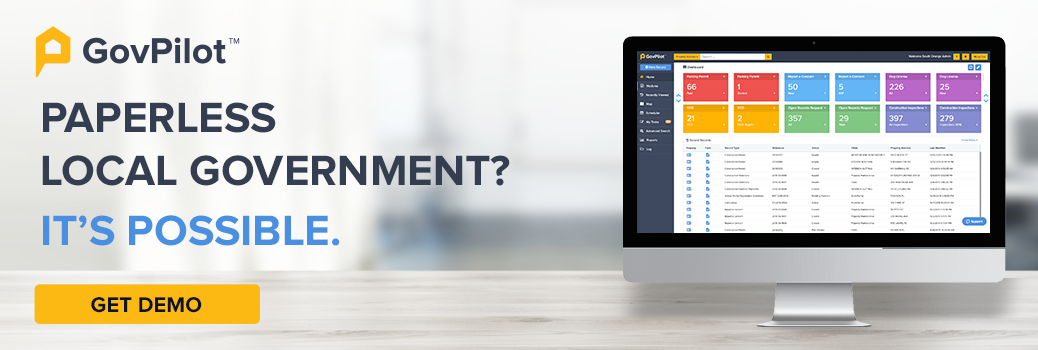Local government challenges have grown ever more complicated in recent years. We’re coming out the other side of a years-long pandemic and witnessing increasingly extreme weather events, all while faith in public institutions is at an all-time low.
The good news is that U.S. residents continue to have higher levels of trust in local governments than they do in state and federal institutions. To maintain this faith, local governments must be proactive in solving modern government challenges — no matter the complexity.
Below we discuss the top issues in local government today, including why local government challenges have changed drastically in the last decade. Then, we’ll provide insights about what your agency can do to meet these obstacles head-on.
Why have local government challenges changed drastically in the last 5-10 years?
The world has changed rapidly in recent decades (and especially in recent years,) and so have local government challenges. The technology boom of the early 21st century increased the quality of life for millions of people, making it easier than ever to access critical goods and services with a few taps on a phone. As a result, citizens have come to expect quick, efficient, and highly-responsive services — which local governments don’t always have the resources to provide.
The pandemic forced public organizations to rethink some of these slow, bureaucratic processes that impede efficient service delivery. Not all local governments have accepted these advancements with open arms, however. Some agencies are hesitant to make changes like telework permanent, leading to high turnover and problems with local government employee retention.
And in today’s increasingly connected world, residents have become more aware of the local government’s role in their day-to-day lives. Citizens demand full transparency and engage with their government in new ways, from participating in budget decisions to starting climate change task forces. Local governments must rise to the occasion to address these complex and interrelated dynamics.
Common Local Government Challenges and Solutions
Below we discuss modern problems in government — and how to overcome them.
1. Ransomware & malware attacks
A technologically-connected world has increased cybersecurity threats, including the number of ransomware and malware attacks that public organizations experience. In fact, local and state governments encounter upwards of 70% of all ransomware attacks in the United States. If not protected, these attacks can paralyze government operations for days — if not longer.
It’s paramount that local governments invest in cybersecurity and other IT technology solutions to counter these attacks, which is why federal cybersecurity grants have recently been made available to local governments. Cloud-based infrastructure helps governments get up and running more quickly after a cyber attack — and with less data loss — than those that rely on physical servers alone.
Learn more about local government cybersecurity:
- Local Government Cybersecurity: Everything to Know
- Local Government Data Breaches: Examples & Lessons
- How to Train Government Workers on Cyber Security Protocols
2. Aging infrastructure
Given limited budgets, local governments struggle to allocate sufficient resources for capital improvement projects. As a result, maintenance of America’s aging roads, bridges, and other infrastructure is continuously deferred. Unfortunately, this leads to more costly fixes down the line.
The Federal Government has recently made strides to modernize America’s infrastructure by providing grants to state and local governments, including funds from the American Rescue Plan Act (ARPA) and Infrastructure Bill. Local governments can use ARPA funds and infrastructure bill grants to invest in digital infrastructure that streamlines internal processes and expedites capital improvement projects.
ARPA funds can be used for physical infrastructure projects too. Here’s resources for making local improvements:
- Building Disaster Resilient Infrastructure: What to Know
- Improving Building Inspections at the Local Level
- How to Build a 15-Minute City
- Municipal Planning: Reclaim Your City Streets
3. Obsolete, Inefficient processes and paper-based workflow
Paper-based workflows slow down government processes, making it challenging for public sector employees to do their jobs efficiently and effectively. For example, your organization might still manually process its Open Public Records Requests (ORPA). This slow process requires that an employee be actively involved in every step of the request and takes up valuable time that could be better spent elsewhere.
Government software can automate these tedious tasks and eradicate unnecessary processes. Tools like digital form submission and automated workflows make it easy for employees to process such claims while reducing the need for inefficient back-and-forth.
Get more insight into how to go paperless in government and the full benefits of a government digital transformation.
4. Loss of trust in government institutions
As the United States becomes increasingly polarized, Americans lose faith in federal and state government institutions. And while local governments have evaded the same levels of distrust, they must remain proactive in maintaining transparency and resident communications to ensure the same fate doesn’t befall them.
Government technology across departments can help your agency improve its resident relations. Tools like complaint management software enable you to receive direct feedback from constituents about their needs. Employees can use this information to remedy problems, whether that involves filling in a pothole, replacing a damaged street sign, or something else entirely.
Learn more about how you can build trust in your local government.
5. Low recruitment and employee retention
The Great Resignation has resulted in high turnover in the public sector. Many professionals are exiting the field for more competitive salaries and flexible schedules in the private sector. As a result, many local governments can’t find qualified professionals to fill vacancies. Local governments can modernize their organizations with online job postings and flexible public work environments.
Comprehensive government benefits, such as low-cost healthcare and robust retirement plans, can also help public agencies remain competitive with the private sector. Additionally, agencies can create a better working environment by automating mindless asks with government software solutions across departments.
Read on for tips about how to hire much-needed government tech workers.
6. Increasing prominence of natural disasters
As the climate emergency continues, local governments will be forced to dedicate their already-limited resources to addressing the impact of natural disasters. This includes preparing for an imminent event through resilience and mitigation efforts, providing immediate emergency response, and managing an efficient long-term disaster recovery operation.
To mitigate the impact of these natural disasters, local governments must invest in resilient infrastructure using local budget resources and federal or state grants. Updating building codes to consider revised flood risks and requiring the use of permeable pavement can help mitigate the impact of climate change on local communities. Utilizing emergency management software will allow for more efficient mitigation tactics and a more streamlined response to a crisis.
Here are specific climate change mitigation strategies for common natural disasters:
- Disaster Preparedness in Local Government
- Tornado Mitigation & Disaster Plan
- Wildfire Mitigation & Disaster Plan
- Flood Mitigation & Disaster Plan
- Landslide Mitigation & Disaster Plan
- Winter Storm Mitigation & Disaster Plan
7. Economic decline
Over the past several years, small businesses have struggled to survive during the pandemic and recent economic turmoil. The pandemic thus led to numerous business closures and decreased the amount of money received from sales tax, a vital source of revenue for local governments.
Governments must foster business-friendly communities that inspire new organizations to settle in the area. You can accomplish this through economic development campaigns and incentives. Economic development software also provides tools that help business owners determine their viability in your community, such as GIS maps showing public parking locations and digital forms that facilitate straightforward business registration.
Read more about the how local governments can drive local economic development and best practices for government budgeting.
8. Water utility challenges
Nearly half of America’s water infrastructure is rated as “poor,” making it increasingly difficult for local governments to ensure residents have access to clean and safe water. Climate change also increases the risk of water scarcity. Local governments must update their water utility infrastructure to accommodate resource needs, both now and in the future.
Public works software helps local governments address water utility challenges by fostering better communication and workflow automation. Employees can use this government management software to take notes in the field, allowing decision-makers to better understand the condition of existing infrastructure and plan capital improvement projects as needed.
Consider these water management tips:
- How to form a local water utilities management strategy
- How local governments can protect local bodies of water
Top Federal Legislation Shaping Public Policy in the Near Future
The Federal Government has recently introduced and passed legislation to help address local government challenges. Three pieces of legislation will drastically shape public policy and public administration:
- The American Rescue Plan
- The Infrastructure Investment and Jobs Act
- The Inflation Reduction Act
The American Rescue Plan Act has put $350 billion of direct aid to state and local governments, which can be used for addressing budget shortfalls from COVID, investing in IT technology and infrastructure, building equitable public programs, and much more. Additionally, local governments can make comprehensive CIP decisions with funds from the Infrastructure Investment and Jobs Act, including modernizing roads, bridges, and water infrastructure. Finally, the Inflation Reduction Act will help local governments address climate change through investments in renewable energy, water infrastructure, and clean energy jobs.
Do you want to learn more about local government trends? Read about Technology and Events Shaping the Future of the Public Sector.
Facing Today’s Challenges in Local Government
You can overcome today’s challenges in local government with GovPilot’s government software solutions. This operating system of local governments modernizes your day-to-day affairs by automating workflows and improving communications. Book a consultation today to learn more about how GovPilot can help your agency overcome whatever local government challenges come your way.
Modern Government Challenges FAQs
What are the top challenges local governments face today?
Local governments face high turnover, making it challenging to provide high-quality services to citizens. As a result, public organizations must consider ways to recruit talented professionals to their organization, such as providing competitive local government benefits. Governments must also maintain service levels despite financial resource constraints and increasingly severe natural disasters.
What challenges have arisen with government constituent relations?
The pandemic taught residents about local government’s role in their day-to-day lives. Additionally, many residents have called to reform and defund police in the wake of George Floyd’s murder. As citizens have become more engaged with their local governments, public agencies have had to balance community demands with resource constraints and essential service provision.
Why has it grown more challenging to recruit government workers?
Local governments must compete with private sector organizations, which generally have more resources to offer higher salaries. Additionally, businesses often provide more flexible scheduling options, including telework, which has become increasingly popular post-pandemic. This has made local government recruiting difficult for organizations that fail to change with the times.
Learn how embracing private sector partnerships can help your agency modernize its operations.
What climate change challenges lie in the future for local governments?
Local governments should be prepared to respond to increasingly disruptive weather events. This includes finding ways to provide access to essential resources, like clean water and shelter, during and after an event. Many local governments may also experience population exodus and inflows as citizens move to more hospitable geographic locations.
Read on:
- Local Government Accountability: Operating a Truly Ethical Local Government
- Local Government Automation: Benefits of Going Digital
- How Do Online Permitting Systems Work?
- What is GovTech? Everything to Know About Government Technology
- Modern Government Trends, Events, & Technology
- Tornado Mitigation & Disaster Plan
- Wildfire Mitigation & Disaster Plan
- Local Government Disaster Preparedness Guide
- Continuity of Government: Government Procedures During a Crisis
- Best Software for Government Procurement
- Building Inspections 101: How Municipalities Can Improve Public Safety
- Government Cybersecurity: How to Prevent Ransomware Attacks
- Municipal Planning: Reclaiming Your City Streets
- Government Blockchain: How Local Government Can Use Crypto
- How Local Governments Can Encourage Civic Engagement







